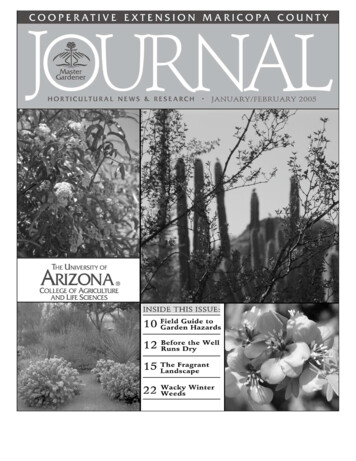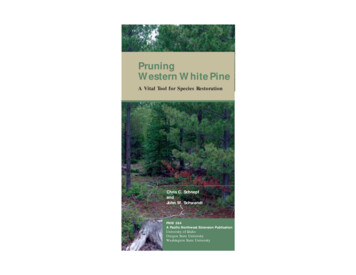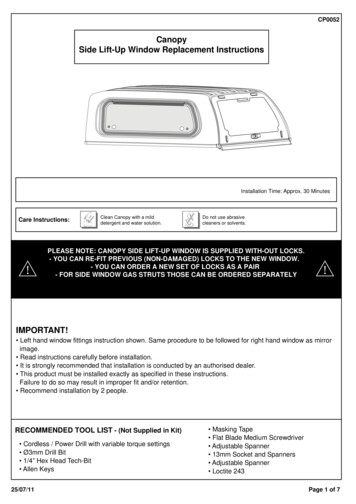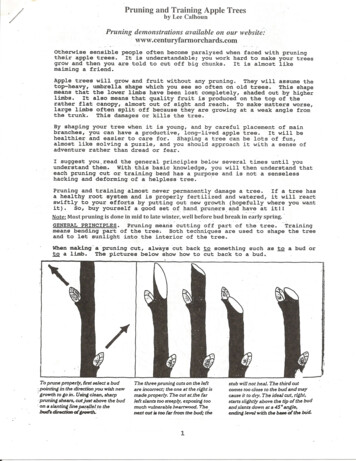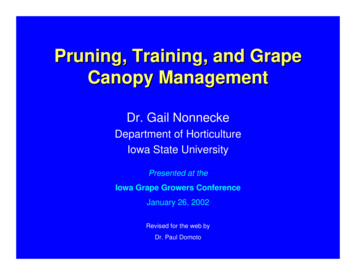
Transcription
Pruning, Training, and GrapeCanopy ManagementDr. Gail NonneckeDepartment of HorticultureIowa State UniversityPresented at theIowa Grape Growers ConferenceJanuary 26, 2002Revised for the web byDr. Paul Domoto
Pruning, Training and GrapeCanopy ManagementContents: Pruning and Training:Single-Curtain Training Systems Canopy Management:Shoot positioningShoot topping
The Grapevine is a true vinethat requires some form ofsupport to keep it off theground. In the wild, tendrilsalong the canes attach toother vegetation and allowthe vine to grow up off theground. In our intensivecultural systems, there is nonatural support for thevines. Therefore, we haveto erect various trellissystems to train andsupport the vines, andfacilitate other managementpractices.Single Curtain Vineyard
Pruning and Training ofGrapevines The culture of grapes dates backto early civilization:- Archaeological evidence that grapeswere consumed by early humans datesback to the early Bronze Age (3,500 B.C.).- The oldest pictorial record of grapegrowing exists in Egyptian mosaics thatdate back to 2440 B.C. Though time, man learned to traingrapevines for both productionand aesthetic value.circa 1500
Grapevine Fruiting CharacteristicDormant buds on 1-yr-oldcanes (last year’s canes)give rise to new (currentseason) canes on whichthe grape clusters areproduced. Because of this character,pruning mature grapevinesconsists of replacing all thefruiting wood each year. This can amount to removing80% or more of the 2-yr-oldcanes and replacing themwith 1-yr-old canes.Dormant bud ona 1-yr-old caneAn emergingcurrent season caneGrape clusters oncurrent season canes!-yr-old cane
Definitions Pruning can be defined as “the removal of plant partsto obtain horticultural objectives”. These objectivesinclude:- Controlling the size & form of the grapevine.- Optimize the production potential of the grapevine.- Maintain a balance between vegetative growth and fruiting. Training can be defined as “the arrangement of plantparts spatially”. This is done to develop a structure that:-Optimizes the utilization of sunlight and promotes productivity.Adapts to the characteristics of the grape cultivar.Promotes efficient & sustainable vineyard management practices.Is economical to establish and maintain.
Pruning and Training YoungGrapevinesSingleTrunkDoubleTrunkGrapevines can be trained with asingle or double trunk. Training vines to a single trunk is themost common and simplest method. In cold climates or with marginallyadapted cultivars, training vines to adouble trunk is often preferred.- If one trunk is killed, the other trunk willprovide some production until the dead trunkcan be replaced.Illustrations from:Ohio State Univ.Bulletin 815, Agdex 231
Pruning & Training Young VinesFrom planting through the thirdgrowing season, pruning andtraining practices areessentially the same for thevarious training systemsused for grapes. Long cane (head) systems:- Kniffen systemsAfter the 1stGrowing SeasonAfter the 2ndGrowing Season Short cane systems (bilateral cordon):- High cordon, single or doublecurtain.- Low cordon w/ vertical shootpositioning.Illustrations from:Ohio State Univ.Bulletin 815, Agdex 231After the 3rdGrowing Season
Pruning Practices at PlantingAfter planting, cut lastseason’s (1-yr-old) canesback to 2 to 3 buds. Training to a single trunk:- Retain one cane. Training to a double trunk:- Retain two canes.Last season’s cane(1-yr-old cane)CuttingFrom: Ohio State Univ.Bulletin 815, Agdex 231
During the First Growing SeasonThe objective is to train the vine upto the desired wire.- Top wire for a high cordon.- Mid-level wire for a low cordon. This requires going through thevineyard several times during theseason and tying up the canes to keepthem vertical. Whenever the canes are allowed todroop over, the axillary (lateral) buds atthe highest point on the cane will beginto grow & the terminal cane growthbecomes stunted. Remove any grape clusters thatdevelop at bloom.From: Ohio State Univ.Bulletin 815, Agdex 231
Single Curtain Training SystemsBi-lateral CordonLow CordonHigh Cordonw/ catch wiresCORDONFrom: Ohio State Univ.Bulletin 815, Agdex 231Suitable for cultivars with a trailing/ drooping growth habit.From: Oregon St. Univ.Ext. Publ. EC 1305Suitable for cultivars with an uprightto semi-upright growth habit.
Growth HabitTrailing / DroopingCharacteristic of American speciesand many French-Amer. hybrids.UprightCharacteristic of V. vinifera& some French-Amer. hybrids
French - American Hybrid CultivarsSuited for a Low Cordon& Vertical Shoot PositioningSemi-upright:ChambourcinChardonelDe ChaunacLa CrossePrairie StarSeyval BlancTraminetteUpright:CheloisSt. VincentVignoles
First Year Training Options Include:-- No pruning, and training allcanes that develop up to thedesired wire.Install grow tubes and allow 1or 2 canes to develop.Prune back to 1 or 2 canesand train them up to thedesired wire.Differences occur in theamount of root mass thatdevelops.Photos from: “ Vineyard Establishment”by Dr. Bruce Bordelon, Dept. of HorticulturePurdue University. Presented at the GrapeGrowing Workshop, Feb. 22, 2001UnprunedTubedPruned to a single shootPruned to aTubedUnprunedsingle shoot
First Year Training OptionsThe use of grow tubes orpruning to 1 or 2 shootspromotes top growth asopposed to root growth. A greater root mass promotesbetter growth the followingyear.Whether one uses grow tubesshould be based on othermanagement practices.- They protect the canes whenherbicides are applied.- They initially protect the vinesfrom rabbits & deer.Photos from: “ Vineyard Establishment”by Dr. Bruce Bordelon, Dept. of HorticulturePurdue University. Presented at the GrapeGrowing Workshop, Feb. 22, 2001UnprunedTubedPruned to a single shootPruned to aTubedUnprunedsingle shoot
First Dormant Pruning(Spring of the 2nd Year)SingleTrunkEstablishing the trunk: Select 1 or 2 of the best canesand remove the others. Remove any lateral canes. If the canes have reached orextend above the desired wirethey can be:- Tied onto the desired wire.- Pruned back to just below thedesired wire to promote newcanes that will be trainedalong the wire.DoubleTrunkPruningCutCut fora SingleTrunkBeforeAfterIllustrations from:Ohio State Univ.Bulletin 815, Agdex 231
First Dormant Pruning(Spring of the 2nd Year)Establishing the trunk: If the canes did not reach thedesired wire, prune back tohealthy wood that is at least3/8” in diameter, or back to 2 3 buds and start the processover. The selected canes should betied to a temporary stake orstring, and to any lower wiresto promote a straight trunk.Illustrations from:Ohio State Univ.Bulletin 815, Agdex 231SingleTrunkDoubleTrunk
During the 2nd Growing SeasonThe objective is to train thenew canes out onto thedesire wire to develop thecordon. Train any canes in close proximityon to the wire. Any canes developing low on thetrunk should be rubbed off whenthey are young. Suckers arising from the groundshould be removed. Any grape clusters developing onthe canes should be removed atbloom.From: Ohio State Univ.Bulletin 815, Agdex 231
2nd Dormant Pruning(Spring of the 3rd Year)Establish the Cordon: Select the best canes basedupon position, vigor, and healthto form the cordon. If the vine has sufficient vigor,prune back the selected canesso that they fill in about 2/3’s ofthe allotted space betweenvines. Prune back any lateral canesdeveloping off the 1-yr-oldcanes to a single bud.Illustrations from:Ohio State Univ.Bulletin 815, Agdex 231BeforeAfter
3rd Growing Season If the vines are developing onschedule, and exhibit goodvigor, they can be allowed tocarry a partial crop. Some cluster thinning may benecessary, particularly withFrench-American hybridcultivars. Rub off any canes developinglow on the trunk early in thegrowing season. Remove suckers developingfrom the ground.From: Ohio State Univ.Bulletin 815, Agdex 231
Pruning Mature Vines *- Practicing Balanced Pruning BeforeAfter3-yr-old Vines(3rd Dormant,Spring 4th Year)Mature Vines(Spring 5th Year& Beyond)* For long cane pruningsystems, canes trainedto the wires are replacedeach year.Illustrations from:Ohio State Univ.Bulletin 815, Agdex 231
Pruning Mature VinesBalanced PruningBalanced pruning is practiced to maintain a balancebetween vegetative growth and fruiting. The amount (weight) of the previous year’s cane growth (1yr-old canes) determines how many buds to retain for thecurrent production year. A base number of buds to retain for the first pound oftrimmings has been established for various cultivars basedon their inherent vine vigor and production characteristics. To compensate for vine vigor, additional buds are retainedfor each additional pound of trimmings removed up to amaximum of 4 pounds.
Balanced PruningWhat Does it Mean?“30 10”The number of buds toretain for the firstpound of 1-yr-oldtrimmings removed. If the vines produceless than one pound oftrimmings, reduce thenumber of budsretained in proportion tothe weight.The number of buds toretain for eachadditional pound of1-yr-old trimmingsremoved. If the weight oftrimmings exceeds 4lbs, do not retain anymore additional buds.
Pruning Mature VinesSteps in Balanced Pruning Size-up the vines & estimate the weight of the 1year-old canes. Remove all 1-year-old fruiting canes EXCEPTthose positioned close to the trunk or cordon thatmay be retained for fruiting.- For long cane (Kniffen) systems, leave the entire cane.- For bi-lateral cordon systems, leave 5 to 6-bud spurs. Weigh the 1-year-old canes from a few vines.
Weighing one-year-old canes
Pruning Mature VinesSteps in Balanced Pruning, cont. Based upon the weight of the 1-yr-oldtrimmings, determine the number of buds toretain per vine.“30 10” balanced pruning system“20 10” balanced pruning system Remove any extra buds to obtain the desiredbud number for the vigor of the vine.The ideal canes to retain are those that are moderately vigorous(about ¼ inch diameter at the 5th or 6th node/bud). Avoid weak &spindly canes with short internodes, and “bull” canes that are verythick with long internodes.
Balanced Pruningfor High-vigor Cultivars“30 10 Rule”Lbs. of Canes12 (30 10)3 (30 10 10)4 (30 10 10 10)# Buds kept30405060** Max number of buds
Balanced Pruningfor Low-vigor American Type Cultivars“20 10 Rule”Lbs. of Canes12 (20 10)3 (20 10 10)4 (20 10 10)# Buds kept20304050** Max number of buds
Balanced Pruning FormulaAmerican Type Cultivars*20 10DelawareElvira25 10CatawbaNiagara30 10ConcordCynthiana / NortonFredoniaSteubenAll other American-typecultivars includingseedless table cultivars* Add additional buds for up to 4 pounds of trimmings.
Balanced Pruning Formulafor French-American Hybrid Cultivars“20 10 Rule” *Small ClusteredMarechal FochLeon MillotBaco NoirMedium Clustered Large Clustered**CheloisChardonelVignoles **SeyvelChancellorChambourcinDe Chaunac* Add additional buds for up to 4 pounds of trimmings. For unlisted cultivars, usethe 20 10 rule for those that are moderately vigorous to vigorous, and the 30 10 rulefor those that are very vigorous.** Usually require cluster thinning, and are thinned to one cluster per shoot.
Balanced PruningCompensating for Winter InjuryBecause the cane buds are the leasthardy portion of a grapevine, it isalways a good practice to inspect thebuds before pruning. Randomly collect 100 buds for each cultivar.Slice through the buds with a razor andexamine them for injury with a magnifyingglass.Record the number of injured buds toassess the extent of injury & determine ifcompensation in pruning is necessary.Healthy1o Injured
Balanced PruningCompensating for Winter Injury 0 to 20 % bud injury:- No compensation is necessary. 20 to 80 % bud injury:- Adjust the number of buds retained inproportion to the extent of injury.- If the weight of trimmings indicates that 50 budsshould be retained and the extent of winter injuryis 40%, then 50 x 1.4 70 buds should beretained. 80 % or more bud injury:- Keep pruning to a minimum! Only remove canesthat will touch the ground.
Balanced Pruning Position of canes and numbers of budson each cane is dependent upon thetraining system.
Training Systems Many “named” systems All contain several basic principles Train canopy growth for– Optimal light interception (photosynthesis)– Optimal air movement (prevent diseases)– Optimal management (rows for equipment)
Training Systems Labrusca types downward growth‘Concord’ - Umbrella Kniffin
Training Systems V. vinifera types upward growth
Single CurtainHigh CordonAlso called “BilateralCordon”Uses 2 wires: Mid-level wire is set 3to 4 ft above theground. Top wire is set at 6 ft. At maturity, 1 wire isadequate.6 ftFrom: Ohio State Univ.Bulletin 815, Agdex 231
Single CurtainHigh CordonSuitable for moderate tovigorous cultivars witha trailing / droopinggrowth habit. Central trunk with cordon(horizontal trunk) istrained to the top wire. Cordon contains “spurs”(5-bud canes), and 1- to2-bud renewal spurs.From: Ohio State Univ.Bulletin 815, Agdex 231
Single CurtainLow CordonSuitable for cultivarswith an upright tosemi-upright growthhabit. Cordon is trained on toa mid-level wire set at 3to 3.5 ft above theground. Additional sets of catchwires are required. Pruning is the same aswith the high cordon,except upright growingcanes are selected.10”10”10”CordonFrom: Oregon St. Univ.Ext. Publ. EC 1305
Single CurtainBeginning the “Cordon”, 2nd Growing SeasonFrom: Ohio State Univ.Bulletin 815, Agdex 231
Single Curtain- Pruning cuts – 3rd SpringFrom: Ohio State Univ.Bulletin 815, Agdex 231
Single Curtain- Pruning cuts – 4th SpringBeforeAfterBud count includes“renewal” spursIllustrations from:Ohio State Univ.Bulletin 815, Agdex 231
Single CurtainDistribution of Buds RetainedLbs ofPrunings# of Budsto Retain# of 5-budCanes# of 1-budRenewal Spurs1304102406103508104601010
Single CurtainPruning Mature VinesBeforeAfterIllustrations from:Ohio State Univ.Bulletin 815, Agdex 231The cordon should fill the space between vines.
cordon
Pruning and TrainingRemember: Beginning the first year, remove any flowerclusters on the shoots (for at least 2 years). Develop straight trunks to the desired wire. Next, develop the cordons. Allow cordons to fill in trellis length.
Grape Shoot Canopy Management
Canopy ManagementRemember: Practices conducted during the growing season willaffect next year’s growth and productivity.- Fruit buds for the current year’s crop were formed during theprevious growing season. To maximize productivity and quality in the currentyear, and maximize the potential productivity for thefollowing year, the leaves have to be positioned tooptimize photosynthesis.
Canopy ManagementRemember: An open canopy is need for:- Maximum sunlight interception &optimum photosynthesis.- Good air circulation to minimizedisease problems.
Grape Canopy ManagementAmerican type grapesgrowing at the BluffsResearch Farm nearCouncil Bluffs, Iowa(circa 1950).
Shoot PositioningOn High Trellis Systems Shoots are positioned so that they are not a “solid mat” ontop of the cordon.- Canes growing along or cross the top of the cordon arerepositioned so that they flow downward from the cordon. Positioning is done after shoots become strongly attached.- When lignin begins to form at the base of the canes (canesbegin to change color from green to brown).- Generally done beginning in early to mid-July.- May have to be repeated 30 days later.
Shoot PositioningOn High Trellis Systems Usually practiced on highvigor vines, or Double-curtaintraining systems whereshoots intertwine.- The practice is often referred toas “Combing”. May be done with Singlecurtain vines to obtain betterpositioned canes.Illustrations from:Ohio State Univ.Bulletin 815, Agdex 231
Shoot PositioningOn Low Cordon Systems Cultivars with an uprightto semi-upright growthhabit adapt well to thelow cordon system andvertical shoot positioning.- Shoot positioning consistsof tucking the canes betweenthe sets of catch wires asthey develop.- This may require severaltrips through the vineyardduring the growing season.From: Oregon St. Univ.Ext. Publ. EC 1305
Shoot ToppingShoot topping is the practice of removing a portionof the cane during the growing season. It is practiced to shorten the skirt of the vine when thecanes get long enough to interfere with culturalpractices. Otherwise, it is not a proven practice.- Timing and length need to be determined.- Remember that whenever leaves are removed, the photosyntheticpotential of the vine is reduced, and this can affect next year’s crop.
Shoot Topping If shoot topping is to be practiced, do it in latesummer.- Avoid doing it during the period of fruit bud formation. Retain at least 11 to 13 leaves per cluster onthe main cane plus any laterals that develop.- Studies in Germany on V. vinifera cultivars found that11 to 13 leaves are required to adequately maturea grape cluster. Any time a cane is cut back, axillary buds nearthe cut will begin to grow.
Shoot ToppingRe-growth If the canes are cut too far back, re-growth willsacrifice clusters for next year. Re-growth uses reserve photosynthates during thecurrent year, and may not properly mature.
Grape canopy managementRemember: Shoot positioning can be helpful tomaximize sunlight interception, andenhance air movement. Shoot topping is unproven.If used - keep major portion of shoot.
Pruning & Training GrapevinesReferences Grapes: Production, Management andMarketing. Ohio St. Univ. Bull. 815, Agdex 231. Pruning Grapes. Cornell Coop Ext. Video 155VPG Pruning Grapes. Michigan St. Univ. Ext. VT021(video)
Definitions Pruningcan be defined as "the removal of plant parts to obtain horticultural objectives". These objectives include: - Controlling the size & form of the grapevine. - Optimize the production potential of the grapevine.



